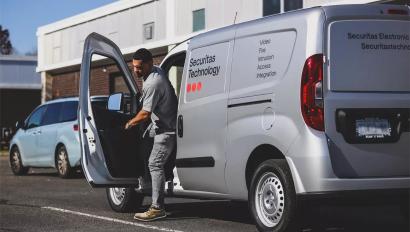Harnessing the Potential of Emerging Technologies to Enhance Electronic Security

Alerting by Exception with Data Edge Analytics
Video surveillance technology enhanced with data analytics capabilities is becoming progressively powerful and affordable, enabling organizations to use their security cameras to prevent incidents rather than just record them. Historically, security hardware has struggled to keep up with the rapid development of the data processing software behind it. Therefore, to experience the benefits of intelligent video analytics, organizations needed significant bandwidth, expensive servers, and graphics processing units (GPUs). Now, thanks to the increased availability and reduced cost of the cutting-edge microchips used by security cameras to process data, that is no longer the case.
The evolution of edge analytics – whereby cameras come equipped with the ability to process large amounts of data themselves (or on “the edge”) – has broadened the possibility for organizations to overlay smart analytics with artificial intelligence (AI) algorithms to their security network. That is because the smart technology used within an edge camera enables it to capture, process, and analyze artificial intelligence data within the device and without sending all that data to a central server. Instead, only the result of the analysis needs to be sent, profoundly reducing bandwidth, and removing the need for a powerful central server altogether.
Edge cameras with built-in video and audio analytics can be programmed to understand their environment, recognize normal patterns of activity, listen for hostile sounds, and identify people and vehicles based on a variety of characteristics. Armed with anomaly detection data, cameras can alert to suspicious activity, audio, or exceptions in expected behavior. For example, they can detect aggression, gunshots, loitering, tailgating, and unfamiliar objects, people, and vehicles entering the scene that could pose potential threats. This proactive approach helps reduce false alarms and facilitates a faster response from remote monitoring operators, who can verify genuine threats and trigger on-site audio to warn off intruders before escalating incidents further.
“AI and Cloud are pushing the boundaries of electronic security and influencing our technology partners in the development of smarter, future-proof solutions. By focusing on the tangible value these innovations can bring, we are committed to helping our clients adopt new features and functionality.”
Sabrina Stainburn
President, Europe, Securitas Technology
Seeking Simplicity and Efficiency from Mobile-first Management
Overseeing important tasks on the go is made easier when the information is readily available in the palm of your hand. This is one of the key industry innovations, which include intuitive mobile applications (apps) that help security managers and business owners to control and monitor their intrusion, video, and access control security systems, remotely.
Utilizing remote access to security technologies via apps, organizations are managing their security more efficiently – from anywhere in the world and at any time of day. Whether wanting to review activity at a certain site or administer changes to a specific system, mobile management gives users a simplistic view of even the most complex security program, as well as providing functionality such as:
- Instant alarm notifications
- Live and recorded video streams
- Remote system control via virtual keypads
- Access to system reports, event history, and activity logs
- User administration and credential management
The need for operational efficiency means that clients now expect access to mobile and desktop applications when implementing or upgrading their security systems. These apps offer key insights into daily system and site activity, such as arming and disarming reports, and visibility of employee time and attendance. As demand for cloud-based technology grows, product developers will continue to invest heavily in new mobile-first features and user-friendly innovations to set their solutions apart in an increasingly crowded space.
Identity and Access Management Trends: Touchless Biometrics
Biometric access control remains the most advanced method of identity management available today. The uniqueness of biological characteristics such as fingerprints and facial features naturally make them ideal credentials for security applications – offering increased levels of authentication compared to more widely used electronic access methods like key codes, smart cards, and mobile credentials.
2025 marks five years since the Coronavirus (COVID-19) pandemic sent shockwaves around the world, causing a significant threat to the health of the global population. The heightened importance of hygiene precautions (to help minimize the spread of the virus) intensified the need for touchless/frictionless access solutions that could help lessen the risk of cross-contamination and virus spreading while maintaining high standards of secure identity management. This only reinforced the benefits of biometrics as the most secure and sanitary access control solution, igniting further investment in this exciting area of technology by both product innovators and end-user organizations.
While fingerprint, facial, iris, and palm recognition are already established forms of biometric access control credentials, in tandem with the expansion of AI and the strengthening of data privacy regulations, we are seeing a growing appetite for frictionless biometrics across the market. This is verified by our Client Advisory Board, with the majority of members either “likely” or “very likely” to implement touchless biometric readers within the organization.
One particular form of biometrics growing in popularity is facial identification technology. By installing facial recognition terminals at key access points, several operational and cost efficiencies can be realized – such as increased convenience for employees and visitors and reduced waiting times. Additionally, redundant physical
access cards or tokens no longer need to be purchased, issued, or replaced. Once a face has been enrolled into the access control system, facial recognition can also be integrated with other applications, including employee time and attendance monitoring. As facial recognition becomes more widespread, we see voice recognition biometrics becoming a technology to watch in the coming years.
Transforming Support Services with Virtual and Augmented Reality Data
Virtual reality (VR) and augmented reality (AR) are high on the list of emerging technologies being explored by organizations in 2025. We see this trend continuing to create new use cases within the world of security, particularly when it comes to enhancing the client experience. Already, security service providers are leveraging
these technologies to power the next generation of service and support. For example, field service technicians can use AR headsets to overlay augmented reality statistics and schematics to equipment in the real world, enabling faster and more efficient repairs. Augmented reality insights and AR-powered apps can also enable skilled remote technical support staff to effectively troubleshoot, diagnose, and fix faults without needing to attend in person – minimizing disruption, costs, and environmental impact. And by leveraging VR and virtual reality data, clients can run virtual security drills, while service providers can deliver immersive technician training.
“Emerging technologies are bringing new ways of thinking to service delivery. Take virtual and augmented reality; the potential to harness these tools to help enhance our client experience is really exciting and a key focus within our technology innovation strategy.”
Kevin Engelhardt
President, North America, Securitas Technology
As the security industry evolves and modern technologies emerge, the possibilities appear endless for both clients and service providers. Now, organizations must continually review the scalability of their security program and consider how new technology trends and features can help them unlock efficiencies in the future.























